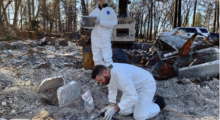
Archaeologists working with Alta Heritage Foundation
search for cremains in the debris of a home destroyed by fire.
Credit: Alta Heritage Foundation
Losing a home in a fire is bad enough, but losing the cremains of a loved one in the ruins adds an extra measure of anguish. Hundreds of families may be in that situation following the massive fires in Los Angeles last January. Now a nonprofit that does not charge for its services is working to bring relief to those families, recovering cremation remains through a highly specialized process: disaster archaeology.
The Alta Heritage Foundation was founded by archaeologist Alex DeGeorgey in 2017 following the devastating Tubbs Fire, which ravaged nearly 37,000 acres in Sonoma and Napa counties. Since its inception, AHF has conducted more than 340 site excavations, assisting more than 350 families in California and Oregon, according to the funeral industry news site Connecting Directors. It estimates that as many as 1,000 families may need the foundation’s help in Los Angeles.
Pairing Archeologists and Dogs
As DeGeorgey says in a video interview, he became the first to fuse archaeology with cremains recovery after a friend asked for help finding the urns containing his parents’ cremains in the rubble of his Santa Rosa home. The city was ground zero in the Tubbs Fire and the location of DeGeorgey’s consulting business. Through research on finding human remains, the archaeologist learned that dogs, which have long been used to recover bodies, could be trained to detect the fainter smell of cremains. He connected with Lynne Engelbert, an associate with the Institute for Canine Forensics, to bring in the specially trained dogs.

Specially trained dogs lead archaeologists to cremains hidden in rubble.
Credit: Alta Heritage Foundation
When a family requests help, the recovery process starts with an interview. “We ask them, who are we looking for?” DeGeorgey explains in the video. “Is this your mother, your son, your husband? What kind of urn or vessel were they kept in? Where in the home were the ashes kept? Then the dogs can follow me.”
Although cremains are commonly referred to as ashes, they are actually pulverized bone — one reason it’s not uncommon for a dog owner to arrive home and discover that their pet has knocked over a loved one’s cremains and devoured half of them.
As the dogs from the canine institute sniff their way over a debris-cluttered foundation, they lie down, as they’ve been trained to do when they get a strong scent of cremains. At that point the humans take over, beginning the slow, careful recovery process of sifting through dirt, plaster, shattered brick and other detritus to recover the cremains. Numbered fireproof medallions that crematoriums include as part of the cremains assists in confirming the identity of the deceased.

Cremains are carefully separated from debris and collected in plastic sacks.
Credit: Alta Heritage Foundation
If an AHS team can get to a homesite before people have walked about and picked through the rubble, the success rate is around 92%, The Washington Post reported in a 2018 story on the Santa Rosa recovery efforts.
“Fortunately, we were able to find the cremains of 50 people in Santa Rosa,” Engelbert told the Post. “The relief of the families was palpable. Many worried the cremains were lost forever and could potentially end up in a toxic waste site.”
Excavating the Remains
Once the location of the cremains has been identified, volunteer archaeologists — many of them college students — go to work, applying the same painstaking techniques used to recover ancient artifacts.
“We’ll excavate it like an archeological feature where we leave the ashes in place and remove all that sediment and debris that aren’t part of the cremains,” DeGeorgey explains in the video. “The last step is to collect those ashes. We bag them and give them back to the landowner.”

A homeowner tearfully receives the recovered cremains.
Alta Heritage Foundation
Mike Newland, an archaeologist working with the foundation, recalls the time he turned over a recovered urn to a homeowner, which made him appreciate the value of the foundation’s work.
“We were there looking for this woman’s father-in-law… When I showed [the urn] to the daughter-in-law, she just started to sob and at that point, I got it… This is an important thing that we’re doing.”

 Recovering Cremation Remains After the Los Angeles Fires
Recovering Cremation Remains After the Los Angeles Fires


 “Help Me, Helen”
“Help Me, Helen”

 “As Tears Go By” by Marianne Faithfull
“As Tears Go By” by Marianne Faithfull














